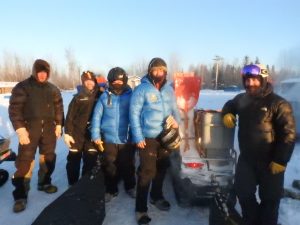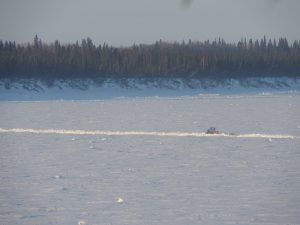Today in Tanana, the world will celebrate the first musher to the Yukon, but the award only voices one piece of the story. At nine am this morning the trail breakers departed Tanana on their snow machines and headed down the Yukon River setting the trail for the teams. The spirit of volunteerism permeates every inch of this trail as an incalculable number of hours are put in behind the scenes. This dedication is embodied in the ethos of the trail breakers.
“There’s a lot of pre-trail work that goes into Iditarod,” Spencer Pape explains. “Sometimes we start as early as January getting equipment ready, getting supplies together, getting tools together, and rebuilding sleds.” In normal years, they’ll go out two to three weeks early to put a trail in the mountains in the Dazelle gorge. They’ll cut ice shelfs, use plywood to build makeshift guardrails, and build ice bridges. Last year, eight volunteers built 32 ice bridges over the span of about ten miles in ten days.
At race time, the trail breakers will stay 24 hours ahead of the mushers to give the trail time to set up. The journey to Nome takes twelve to thirteen days and in that time they’ll place roughly 15,000 lath trail markers. Most days, they’ll cover 70-80 miles, but trail detail will drop their average speed down to three and a half to four miles an hour—a contrast to the dog teams’ average of eight to nine. In addition to breaking trail and setting markers, these guys are cutting deadfall, clipping branches, picking up brush, and anything else they can do to make the trail as clear and safe as possible. If a big snowstorm comes through a couple of the guys will backtrack and lay new tracks so the teams know where they’re going.
A few years ago on the southern route. The weather was so bad the volunteer Air Force couldn’t fly supplies into Eagle Island to set up the checkpoint. Other than a few local volunteers, no one had arrived except the trail breakers. Spencer recalls, “We ran up ahead to the next big village where they could get IFR planes in, picked up everything at 2:00 in the morning and hauled it all the way back down the trail to set up Eagle Island checkpoint.
When asked about the impassable deep snow conditions that had been reported prior to their arrival, the guys laugh. Jeremiah (JR) Melin explains, “It happens every year. It’s always the worst trail conditions ever. It’s impassable; the race is going to have to be canceled.” Yet the team has yet to be thwarted. “We have the best machines there is for the job that we’ve got. It’s really hard to find snow conditions these things can’t go through. We’re all very experienced riders. We know what we’re doing on these things.”
Still, there is always uncertainty up ahead. Debate persisted about whether to route the early part of this year’s trail overland or on the river. “We put 30 miles of lath in not knowing if when we get to this stretch that everybody’s saying is so bad—snipping brush, putting lath in—hoping we don’t have to turn around […] and pick up all our lath.
Mechanical issues arise. They’ve had to rebuild suspension, change spark plugs, and swap out belts. This year a machine broke through ice into five feet of water but the team salvaged it. And that’s the point: these guys are a team. A team can rescue snow machines and build fires for a soggy rider, whereas a lone individual would be lucky to have enough calories to run around and stay warm.
Most of the team began as volunteers in other aspects of the race. Jake Fletcher raked the dog yards at checkpoints for several years and Cameron Gray began volunteering in his village of Unalakleet when he was eight—the same year he started mushing dogs.
Jake says of him, “It’s easy to find people that will come in the first two days at a checkpoint, but when you have
people coming in 80th place, after all the luster has worn off the gold, all the same work needs to happen. That’s where guys like Cameron are out there grinding.” People like Cameron are invaluable to the race.
Cameron’s dedication didn’t go unnoticed. At thirteen, the Iditarod sponsored a program to fly young volunteers from their home villages to Anchorage to see the start of the race and Cameron’s hard work made him a natural choice. Now Cameron has a young son whom he hopes to share the trail with and pass his role onto him—a tradition for which there’s precedent.
Jeremiah (JR) Melin is a second-generation trail breaker. His dad instituted the grooming aspect of the race, and when JR was fourteen he began volunteering, as well. That was twenty years ago. Now he’s the primary guy pulling the groomer.
The trailbreaker’s families couldn’t be prouder. Last night their wives and kids shared a pizza night and watched them on the tracker.
Spencer says, “We all take a lot of pride in this. We look forward to it every year. We take a lot of pride in the race; a lot of pride in the state.”
Cameron agrees, “It’s the favorite sporting event for all of us, I think.”
“It’s called the last great race for a reason,” Spencer nods. “We’ve got the results right here laying in front of us rooting for our favorite team. And we just love being a part of it.”





































